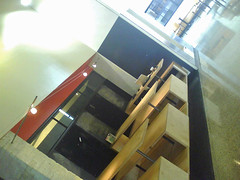Milwaukee.
Up next in this panel at AoIR 2009 is Simone Pereira de Sá, whose focus is on music recommendation systems; such systems are mediators or translators to which we delegate the task of recommendation. They promise something else for the different actors in the process: artists are presented to the right people, while listeners find new music they should enjoy, and this is further enhanced through social networking tools and tagging functionalities.
Labelling systems deal with the complex issue of music classifications, choices, and tastes, and this ties into the question of musical genres - so, how do recommendation systems work on this basis, and strain, support, or overcome the idea of musical generes? As Simon Frith has suggested, one of the greatest pleasures of entertainment culture is the discussion of different values and tastes; different opinions have different levels of credibility here. This is also connected to subcultural theory, of course, which ascribes certain subcultural capital to agents in contact with the media and refers to consuming certain exclusive information and the 'right' cultural products.














